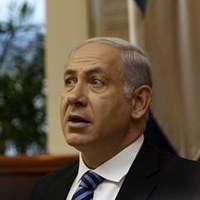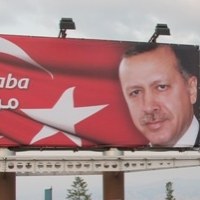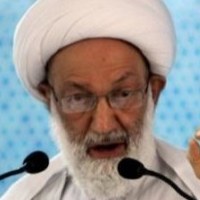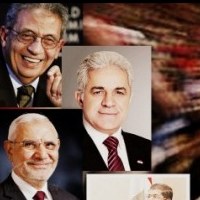![]()
Sun, Sept 26, 2010 | The Meir Amit Intelligence and Terrorism Information Center

The Turkish passenger ship Mavi Marmara, the flagship of the flotilla. It is decorated with the Turkish flag and the logo of the Turkish Islamist organization IHH, the moving spirit behind the flotilla (next to the Turkish flag) (Photo from mycatbirdseat.com, May 22, 2010)
The Ideology Behind the Mavi Marmara Flotilla
Conspicuous among the passengers and organizations aboard the Mavi Marmara were Turkish and Arab Islamic extremists led by IHH. They were joined by extremist European left activists and volunteers who answered the call to help the Palestinians in the Gaza Strip and were not partners in IHH’s violent plans.[1]
Executive Summary
1. This objective of this report is to examine the 561 passengers aboard the Mavi Marmara, their identity and the ideology, nature and goals of the organizations behind them, based on the large amount of evidence accumulated since the flotilla. Even if our information is not complete, it clearly provides a picture of their most prominent common characteristics.
2. The Mavi Marmara, the flagship of the last flotilla, was launched, along with two cargo ships, by an extremist Turkish Islamist organization called IHH, which played a key role in the extensive preparations for the voyage. The IHH operatives, some of whom boarded the ship in Istanbul without undergoing a security check, were those who were the most active assailants in the violent, premeditated confrontation with the IDF (while the IDF took control of five other ships – as well as the Rachel Corrie – without exceptional incident).
3. An examination of the Mavi Marmara passengers and organizations sheds light on the coalition the flotilla’s activists and organizations belonged to. They came from many countries and differed in nature and ideology, from extreme Islamic to the extreme left. Most, but not all, were united by a common hostility to Israel (and sometimes to the Jewish people), support for Hamas and its ideology, and hostility to their perception of the liberal West, as it is today.
4. The analysis contained in this report is based on the Mavi Marmara’s passenger list seized aboard the ship, categorized according to national affiliation and port of embarkation (See Appendix I). The analysis of the passengers’ identity and the dozens of participating organizations is based on a great amount of varied information: statements made by Mavi Marmara passengers during questioning, documents found on the Mavi Marmara and other ships in the flotilla, open source media information (including the Turkish media), open source information from the participating organizations and information from Israeli security souces.
5. Of the 561 Mavi Marmara passengers, 380 were from non-Arab Islamic countries (mostly Turkey) 107 from Arab-Islamic countries and 74 from the West. Examination provided the following insights:
A. The flotilla was basically a Turkish project. More than 60% of the passengers, 353, were Turkish. There were Turkish passengers, including IHH activists, aboard two other ships, the Gazze and the Defney, as well.
B. The largest Arab delegations were from Algeria (32 participants) and Jordan (31 participants).
C. Only 13% of the passengers were from Western countries. The largest delegation was British (28 participants). Conspicuous among the Western passengers were activists of Arab-Muslim origin. Some had previously participated in the land and sea convoys to the Gaza Strip and some were involved in anti-Israel activity in their home countries.
6. Ideologically, many Mavi Marmara passengers belonged to extremist Islamist organizations, especially the Turkish IHH and other Islamist organizations operating in Turkey. There were also Arab and Western activists affiliated with the Muslim Brotherhood. There were Western radical left activists, who were in the minority. There were also volunteers, motivated by an authentic desire to help the Gazans. This melting-pot coalition was led by IHH and united by their common hostility to Israel (and sometimes to the Jewish people), support for Hamas (not for the Palestinian Authority), and hostility to the West and its values.
7. The flotilla had the following goals:
A. It was the showpiece of a broad international coalition whose main political objectives were to isolate Israel, wage a smear campaign against it, increase international pressure and finally to turn it into a pariah state and delegitimize its existence.
B. An examination of the documents and statements issued by IHH and the Free Gaza Movement (FGM), the two most prominent organizations participating in the flotilla, shows unequivocally that the objective of the flotilla was not to bring humanitarian assistance to the residents of the Gaza Strip, but rather entirely political:[2] An internal FGM document, the IHH website and a statement made by Bülent Yildirim two months before the flotilla to an audience of Islamist supporters give witness to a series of political-propaganda goals: to show support for Hamas, to force Israel to change unilaterally its policy of closure of the Gaza Strip (while completely ignoring the security considerations which led to it), to create a media circus regarding the so-called “siege” and to isolate Israel.
C. The FGM and IHH had their own particular motives. There are indications that IHH also intended to further complicate the troubled relations between Israel and Turkey, which have been problematical in any case since Prime Minister Erdogan rose to power, by violently opposing the IDF while emphasizing the Turkish aspect of the flotilla. The FGM also had its own motive for wanting the flotilla to succeed (according to an internal document), to improve its ability to raise funds for its activities in view of its financial difficulties.
8. The organized violence aboard the Mavi Marmara:
A. From the beginning, IHH prepared to employ extreme violence against the IDF and implement a plan which included preparing battle positions, equipping the operatives with and offensive and defensive weapons, and briefing them before the battle. To that end weapons and equipment were loaded aboard the Mavi Marmara and improvised weapons were made during the voyage. The latter included lengths of iron pipe, wooden clubs, axes, knives, Molotov cocktails and slingshots. Information in our possession indicates that there were one or two guns aboard the Mavi Marmara and that at least one was fired at the IDF soldiers as soon as they descended from the helicopter. In addition, IHH operatives took three guns from IDF soldiers and turned them against the forces. Eight IDF soldiers were wounded; two of them were shot (one with ammunition not in IDF use – i.e., which belonged to IHH – and the other with a weapon taken from a soldier).
B. An examination of the names of the Turks killed indicates that almost all of them (eight of the nine) belonged to IHH or were from political parties or other organizations affiliated with it. Most of them (seven of the nine) had announced in one way or another before the violent confrontation that they intended to dies as shaheeds. It is difficult to assesses the degree of enthusiasm and authentic commitment of each of those who sought to fulfill his aspiration to become a shaheed, but their stated intention provides a clear indication of the nature of the hard core of the operatives who confronted the IDF forces aboard the Mavi Marmara.
C. An examination of the names of the 53 wounded in the confrontation whose names appear on the list issued by IHH, show that all except one were Turks. Most belonged to IHH or Turkish Islamic organizations collaborating with it. None of them belonged to pro-Palestinian or Western or Arab-Muslim human rights organizations with the exception of one man (who was not seriously wounded) from Indonesia.
9. Employing extreme violence while paying lip-service to non-violence:
A. The flotilla’s organizers often made a point of representing themselves as pro-peace and human rights activists (the flotilla was called the “Freedom Flotilla”) whose activities were non-violent. In reality, there is a great deal of information illustrating the fact that IHH planned and prepared for a violent confrontation with the IDF soldiers. IHH has a history of violent behavior, which was made evident during its confrontation during the previous overland convoy, in which the organization’s leader Bülent Yildirim participated, with the Egyptian security forces in January 2010.
B. Apparently most of the human rights activists aboard the Mavi Marmara, including those who had joined the IHH coalition, were not aware of the high level of violence IHH intended to employ during the voyage.[3] However, we have proof from an internal FGM document attesting to the fact that the organization considered that “the only way for Israel to stop [the flotilla] is to use force.”[4] The organization proposed various scenarios for possible tactical responses, such as surrounding the ship with iron bars, strewing the decks with sharp obstacles and having activists barricade themselves in the wheel house and engine room. The level of FGM violence was far below that of the organized violence prepared and implemented by IHH (which included the use of guns). However, it was contrary to the instructions the FGM gave its activists, which unequivocally forbid the use of any form of violence, physical or verbal. The expression non-violent resistance, as used by human rights organizations, is apparently open to wide interpretation.

The placard reads, "To Gaza never mind the price" (Picture seized by IDF soldiers aboard one of the ships). Bülent Yildirim, speaking to supporters two months before the flotilla set sail, said that in every scenario, including an Israeli attempt to take over the ship, the IHH was determined to protect the flotilla and to continue to the Gaza Strip to "break the siege."
10. In effect, during its preparations for the flotilla, IHH’s approach was pragmatic while the organization indulged in doublespeak.
A. When speaking to its supporters in Turkey, the IHH leader did not conceal its extremist Islamist ideology and presented the flotilla as part the struggle waged by Islam against the so-called combined “attack” carried out by the countries and powers around the world (the United States, NATO, Russia and China). In the same breath IHH praised Hamas and used belligerent, extremist Islamist terminology.
B. However, on its website and in several statements to the press and interviews given by its senior members (primarily in English), IHH stressed it was providing “humanitarian assistance,” using the terminology publicly employed by NGOs and pro-Palestinian Western organizations.
11. Involvement in global terrorism of the organizations and activists participating in the flotilla:
A. The Turkish IHH, which organized the flotilla in close cooperation with the Turkish government and played a major role in attacking the IDF aboard the ship, supported the global jihad in the past. Reliable information indicates that alongside its extensive humanitarian activity, in the past IHH had ongoing relations with Al-Qaeda and global jihad networks in the Middle East and beyond, and for that reason was in the crosshairs of previous Turkish regimes. Its ties to terrorism were manifested chiefly through the provision of logistic support for transferring weapons and funds to terrorist operatives, including terrorists planning a terrorist attack in the United States, which was prevented (the “millennium attack in Los Angeles, January 2000).
B. One of the IHH operatives aboard the Mavi Marmara participated in the terrorist attack of a Russian ferry in 1996, intended to secure hostages as bargaining chips for the release of Chechens from Russian prisons (although IHH as an organization was not involved in the attack).
C. We have no evidence that the other organizations participating in the flotilla have been involved in the global jihad, although it is possible that a number of radical Islamic operatives aboard the Mavi Marmara (and other ships) had ties, in one way or another, to global jihad organizations.
12. Support for Hamas:
A. IHH and the FGM, the two most prominent organizations behind the flotilla, have a common past of support for Hamas. They have transferred money and material aid to the de facto Hamas administration in the Gaza Strip and given it political-propaganda support. Other organizations from Turkey and the Arab-Muslim world which participated in the flotilla gave aid to Hamas in the past, mostly financial (directly or through the Union of Good) and material, and by joining the campaign to smear Israel in Arab-Muslim world and in the West.
B. In addition, many of the extremist Islamist organizations which were represented aboard the Mavi Marmara share Hamas’ ideology, inspired by its parent movement, the Muslim Brotherhood: They are hostile to Israel, reject the peace process, oppose the Palestinian Authority, hate the West and its values and support the path of “jihad” (i.e., violence and terrorism) as the way to “liberate Palestine.” Some of the leftist activists in the West who belong to the coalition hold similar anti-West anti-Israel positions, but their perspective is completely different.
C. Organizations operating in the United States and other countries where Hamas has been designated as a terrorist organization are careful not to publicly support the movement and instead use the acceptable pretexts of supporting the Palestinians in Gaza or of providing humanitarian assistance for the needy. The FGM instructed its activists in that spirit, as was illustrated by internal documents seized aboard the Mavi Marmara.
13. The battle for hearts and minds and the importance of media backing: The organizers of the flotilla were well aware of the great importance of media coverage in furthering their aforementioned political goals. They made sure that correspondents, cameramen and Internet personnel were aboard the flotilla. The Turkish delegation alone had 33 correspondents and there were dozens of others who participated in the Arab-Muslim and Western delegations. An examination of the media personnel revealed that most of them worked for Arab-Muslim media (including extremely popular media, such as Al-Jazeera TV), but the leading Western newspapers and television channels were not represented.
14. The Turkish government’s support of the flotilla: The flotilla’s organizers have tried to represent it as the fruit of a joint effort of various NGOs without government support. In reality, the flotilla received outright Turkish government support, without which it is doubtful whether such a large operation could have been realized. In addition the Turkish government did not make an effective effort to prevent the flotilla from sailing, despite the fact that its organizers took into consideration that they were exposing themselves to significant risks should they enter into a confrontation with Israel. For example:
A. Information in our possession, based, among other things, on documents seized aboard the ships, the results of questioning the passengers, and the Turkish media, indicates extensive involvement of the Turkish government in the flotilla. That involvement increased, and metamorphosed from behind the scenes involvement during the first stages of the flotilla’s planning to open, blatant involvement during and after the last stages.
B. According to the minutes of a meeting of the coalition’s representatives on May 16 (Appendix B), IHH’s vice president, who chaired the meeting, said that “Government did not announce openly support for the mission at first; but [in the] last few days, [we have been] getting direct support from PM and other ministers. During F2F discussions, [they] openly said that if we have any difficulties, gov[ernment] will extend what support they can” (ITIC emphasis). In addition, he recently said publicly that the Turkish government and its intelligence service did not undertake any action or ask the organization to cancel the flotilla or return to port at any stage.
C. From the beginning, Istanbul was the nerve center of the intensive, IHH-led preparations for the flotilla, which began half a year before it was launched. The Mavi Marmara sailed from Istanbul after a well-attended ceremony which was fully covered by the media. A similar ceremony was held in Antalya. IHH and other Islamic Turkish organizations which participated in the flotilla were well-connected to the Islamic regime in Turkey. Turkish governmental support was manifested in organizing the flotilla, providing its organizers with governmental capabilities such as logistics and funds, and by swathing it in governmental political-propaganda protection (manifested in the Turkish government’s media attack regarding Israel’s takeover of the ship and Turkish pressure exerted on Israel). It can be assumed that the purchase of the Mavi Marmara from a company owned by the Istanbul municipality (Prime Minister Erdogan was at one time Istanbul’s mayor) and the purchase of the two cargo ships was accomplished, directly or indirectly, with government financial support.
D. According to our information, IHH leader Bülent Yildirim and other senior figures in IHH have close relations with Turkish Prime Minister Erdogan and his AKP party. IHH works in close collaboration with a Turkish government institute called TIKA, the Turkish International Cooperation and Development Agency. TIKA, which was established in 1992, answers to the prime minister’s office and is an influential branch of the Turkish government, the Muslim world in general and among the Turkish-speaking communities in particular.
15. The degree of involvement or support of Arab-Muslim regimes: The degree of that involvement differed from one country to another. There were countries which gave their blessings to the activists and those whose nationals aboard the Mavi Marmara indicated a kind of defiance of the regime. For example, the large Algerian delegation was composed mainly of members of a moderate Islamic party which generally cooperates with the regime. The Yemini delegation included members of the parliament belonging to the extremist Islamic Al-Salah party, which is part of the regime. The Syrian delegation did not include members of the regime but received the regime’s blessing in the form of a meeting with Bashar Assad when they returned. The large delegations from Indonesia and Malaysia were composed of members of pro-Palestinian NGOs and received the blessings of their various regimes. The Jordanian delegation, on the other hand, included Muslim Brotherhood activists and members of the labor unions which oppose the regime, and the Egyptian delegation had members of the Egyptian parliament who also belonged to the Muslim Brotherhood, which opposes the regime.
Contents
16. This report contains two sections and three appendices:
A. Section I – Cross section of the passengers:
1) Passenger distribution according to nationality and religion.
2) Passenger distribution according to organizational affiliation.
B. Section II – The most prominent activists and organization aboard the Mavi Marmara (distribution according to country):
1) Turkey and other (non-Arabic) Muslim countries.
2) Western countries.
C. Appendices:
1) Appendix I – A list found aboard the Mavi Marmara of passengers, arranged according to nationality.
2) Appendix II – An analysis of the minutes of the meeting held by the flotilla organizers on May 16, 2010.
3) Appendix III – A list of the Turkish passengers aboard the Mavi Marmara and other ships and their organizational and political party affiliations.
Notes:
[1] This is an executive summary of a detailed report analyzing the human, ideological and organizational components of the passengers aboard the Mavi Marmara. The document itself shortly will be issued separately.
[2] Hamas also admitted that the objectives of the flotilla were not only humanitarian. Ismail Haniya, when asked about the fact that after the flotilla incident Israel had eased the closure of the Gaza Strip, said that “The basic problem is not the aid itself, despite its great importance and the Palestinians’ need for it, but the subject is the siege, which we demand be fully lifted. We refuse to separate the two and turn the problem into only a humanitarian one” (Interview with the Al-Islam Al-Youm website, June 26, 2010).
[3] From public statements made, there were some activists who did have an idea of what would happen. Kenneth O’Keefe, a former Marine who sailed aboard the Mavi Marmara and participated in the confrontation, told an Israeli correspondent that from the beginning it was clear that the Turkish operatives intended to fight the IDF and that there was no question of passive resistance:
“I knew before we set out that the Turks are not like the other Westerners, that there would be no passive resistance in this case. The Turks are a tough people. They are people you don’t mess with too much. In the United States or Britain people are asleep, there is no danger of rebellion. The Turks are different. I knew that if the Israelis boarded that ship, it would be a disaster. Not only from the aspect of the people who would be killed, but that it would also be a disaster for the Israelis.” When asked if he saw them sawing beams, he said, “I knew we would defend the ship. That was stated publicly a great many times. You have to be an idiot to board that ship and think it will be a ship of passive resistance.”
Noam Sheizaf Haaretz weekend magazine, September 24, 2010, haaretz.com.
[4] For further information and the full text of the document, see the June 28, 2010 article, “Inside documents of the Free Gaza movement seized in the recent flotilla expose considerable discrepancies between its strategy and tactics and its public stance. The documents prove, among other things, the attempts to conceal the aid to the Hamas administration since Hamas is designated as a terrorist organization in the US” by the Meir Amit Intelligence and Terrorism Information Center.



 RSS
RSS


















The Ideology Behind the Mavi Marmara Flotilla | #israel #ihh #gaza #flotilla http://j.mp/aayzNt
RT @CrethiPlethi: The Ideology Behind the Mavi Marmara Flotilla | #israel #ihh #gaza #flotilla http://j.mp/aayzNt
The Ideology Behind the Mavi Marmara Flotilla http://j.mp/gHCgal #Turkey #Gaza #Hamas #IHH #Israel
[…] The Turkish IHH, which organized the flotilla in close cooperation with the Turkish government and played a major role in attacking the IDF aboard the ship, supported the global jihad in the past. Reliable information indicates that alongside its extensive humanitarian activity, in the past IHH had ongoing relations with Al-Qaeda and global jihad networks in the Middle East and beyond, and for that reason was in the crosshairs of previous Turkish regimes. Its ties to terrorism were manifested chiefly through the provision of logistic support for transferring weapons and funds to terrorist operatives, including terrorists planning a terrorist attack in the United States. [The Meir Amit Intelligence and Terrorism Information Center, Sept 26, 2010] […]